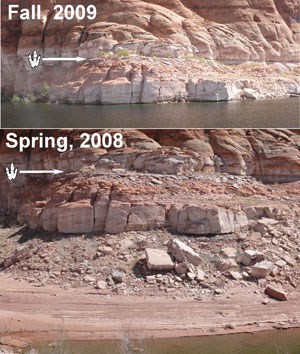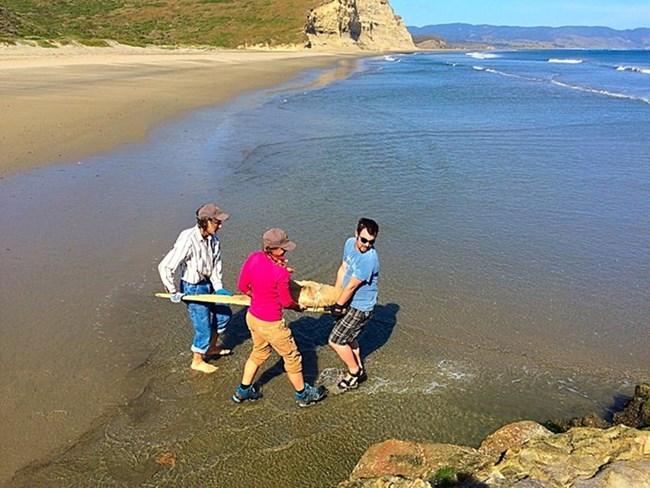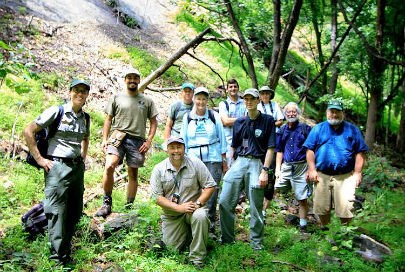Introduction
What is paleontological resource monitoring and why is it important?
Paleontological resource monitoring is a critical part of managing fossils on National Park Service lands. Fossils are non-renewable resources, which means they are irreplaceable evidence of past life on Earth. Fossils possess scientific, educational, and other values worth considering in their management and protection. Once a fossil is gone, it is gone forever, and we lose any opportunities for scientists to study or park visitors to discover, experience and learn about these prehistoric animals and plants. Monitoring fossils preserved within geologic strata is important to assess the stability and condition of the fossils which are exposed to a variety of potential natural and human related threats.
Fossils have been documented in at least 280 different national park units and are abundantly preserved in some of these parks. All fossils discovered in national parks are not collected and placed into a museum, rather many are left in place for park visitors to observe and learn about. For some visitors, viewing a fossil naturally preserved in a rock exposure may be the first time they discovered a fossil “in the wild.” This can be an exciting and enriching experience for many through this first-hand and often meaningful connection to a prehistoric lifeform from long ago. Therefore, monitoring of park fossil provides valuable information to inform park staff on how to best maintain and protect these resources to enhance opportunities for public enjoyment and understanding.
Regular and periodic monitoring of fossils helps to identify when and what types of factors may place the exposed fossil at risk to damage, destruction or unauthorized collecting. The techniques and strategies used in monitoring of fossils are designed to observe, document and recognize any changes or impacts to fossils over time during repeated assessment of a fossil locality. The use of photography and photogrammetry are valuable monitoring tools when determining the factors influencing the stability and condition of fossils. Sometimes monitoring fossil localities alerts park managers for the need to collect an at-risk fossil specimen from the field.
Another benefit associated with the monitoring known fossil localities is the potential for the discovery of new fossil remains which may have become exposed at the surface over time. Weathering and erosion at the surface at known fossil localities may lead to the uncovering of fossils previously concealed beneath the surface. If newly exposed fossils are able to be evaluated and possibly salvaged before natural processes degrade the specimens, there have been cases where important fossil discoveries when occurrence during monitoring. Several case studies presented below provide examples of where important fossil discoveries were made during paleontological resource monitoring in national parks.
The importance of monitoring fossils in national parks is further reinforced through the Paleontological Resources Preservation Act (PRPA) [Link—Site Under Development] which mandates paleontological resource monitoring. The National Park Service presented an initial strategy for paleontological resource monitoring in 2003 (Santucci and Koch, 2003) and a more comprehensive strategy in 2009 (Santucci, et al., 2009). Every paleontological locality is different, and every park presents different conditions and variables associate the park’s fossils. Therefore, paleontological monitoring is not “one-approach-fits-all.” Instead, to be effective, a monitoring program needs to be tailored to a park and some park’s have created a “Paleontological Resource Monitoring Plan or Strategy” to address specific park needs.
References
-
Santucci VL and Koch AL. 2003. Paleontological resource monitoring strategies for the National Park Service. Park Science. 22(1):22–25—Download at [IRMA Portal]
-
Santucci VL and Others. 2009. Monitoring in situ paleontological resources. Pages 189-204. In Norby L. Geological Monitoring. Geological Society of America. Boulder, Colorado.—Download at [IRMA Portal] or view on webpage NPS—Geological Monitoring—Paleontology.
Glen Canyon—Case Study

At the time that Paleontological Resources Preservation Act was enacted in 2009, Glen Canyon National Recreation Area (GLCA) was chosen as the prototype paleontological monitoring park for the NPS. This park preserves a rich and diverse fossil record, primarily fossil vertebrate footprints from within Triassic and Jurassic rocks. Hundreds of fossil track localities have been documented at the recreation area, including many along the shorelines of Lake Powell. The significant fluctuations in the water level of Lake Powell results in many of the fossil track localities being intermittently submerged during periods of high-water levels and exposed during periods of low-water levels.
The monitoring protocols established for GLCA are designed to evaluate both short-term and long-term impacts to fossil localities. This includes a variety of natural processes including, but not limited to: rockfalls, landslides, erosional undercutting of strata, wave action, flooding, leaching of natural sedimentary cement matrix, and freeze-thaw cycles. Paleontological resource monitoring at GLCA has documented instances of fossil related crimes including theft and vandalism. Fossil localities at GLCA have been ranked in terms of their significance and vulnerability to establish appropriate periodicity for scheduling monitoring.
George Washington Birthplace—Case Study
George Washington Birthplace National Monument (GEWA) in eastern Virginia provides a significant example demonstrating the value of monitoring paleontological resources. This park is not usually thought of for its paleontological resources, but its historical sites are established on a bluff developed on the Miocene-aged Calvert Formation (about 15 million years old) overlooking the Potomac River. Abundant marine fossils erode from the bluff or wash up on the shore. NPS Paleontology Program staff began periodic visits to GEWA in 2014 to assess the state of the resources and the nature of the issues facing them. A traditional site-based monitoring program would not be effective at the monument because of the high rate of bluff erosion and the widespread exposure of fossiliferous strata. Another consideration related to paleontological resource monitoring at GEWA is associated with the long history of visitor fossil collecting at the monument. The NPS Paleontology Program and GEWA staff collaborated to establish an effective monitoring program and to find ways to reduce the removal of fossils by visitors.
All of this planning and work related to monitoring GEWA’s paleontological resources paid unexpected dividends in early 2020. One of the monument staff monitoring exposed fossils along the bluffs at GEWA observed some fossil bones beginning to emerge at the surface. NPS Paleontology Program staff and paleontologists from the Calvert Marine Museum recognized that these bones were likely those of an ancient marine mammal and scheduled an emergency recovery of the fossils.
On March 16, 2020, park staff and the paleontologists excavated the fossils, which proved to include a partial skull of a long-snouted extinct dolphin. An even more complete skull was found nearby and also excavated. The investment in paleontological resource monitoring at GEWA was rewarded through the discovery and successful rescue of two Miocene dolphin skulls that will be available for scientific study and public education. You can read more about this event here:

Photo by Sarah Boessenecker.
Point Reyes—Case Study
During 2014, paleontological resource monitoring was initiated at Point Reyes National Seashore (PORE) to assess active geological processes and their impacts on the highly fossiliferous cliffs along the national seashore’s coastline. Pliocene-age marine sediments at PORE preserve an important assemblage of fossil marine mammals, including whales, dolphins and pinnipeds, which inhabited the ancestral Pacific Ocean. Collectively coastal processes, such as oceanic waves, tides, winds, storms and sea level rise, influence the stability and erosional rates of the fossil-rich exposures at PORE. Additionally, unauthorized fossil collecting by park visitors from within the national seashore was documented during fossil monitoring at PORE. One of the unanticipated benefits from the monitoring at PORE led to the discovery of the fossil remains of a short-beaked dolphin which appears to be a new species. The specimen was successfully collected by the paleontology team involved in the monitoring and is curated into the park collection awaiting study and description.

NPS photo.
Chesapeake & Ohio Canal—Case Study
Chesapeake and Ohio Canal National Historical Park (CHOH), is a 186-mile-long park extending from Washington, D.C. to Cumberland, Maryland. The park crosses through several geologic provinces which include fossiliferous Paleozoic marine rocks. The main trail is easily accessible from heavily populated areas and is a popular recreational location. The development of a paleontological resource management strategy for CHOH required an innovative approach for periodic evaluation of fossil sites over the long distances within the park.
In 2014, CHOH and the NPS Paleontology Program established the Paleo-Protectors Program to support the monitoring of fossils along the long-distance park. This volunteer program was modeled after the CHOH trail patrol team and recruited some the most experienced and trusted trail patrol members to join the first team of Paleo-Protectors. Members of the Paleo-Protectors participated in both classroom and field training to understand the various methods and procedures they would employ during their work monitoring fossil localities at CHOH. Members were assigned a segment of the trail in which they would undertaken periodic monitoring and to observe and record information regarding the stability and condition of the many known fossil sites along the CHOH trail.
The CHOH Paleo-Protectors represent an innovative, cost-effective, and successful approach for paleontological resource monitoring and site stewardship. This program serves as a model for how other parks and agencies with fossils can enhance the preservation of non-renewable fossils.
Related Links
-
Chesapeake and Ohio Canal National Historical Park (CHOH), D.C., MD, and WV—[CHOH Geodiversity Atlas] [CHOH Park Home]
-
George Washington Birthplace National Monument (GEWA), Virginia—[GEWA Geodiversity Atlas] [GEWA Park Home]
-
Glen Canyon National Recreation Area (GLCA), Arizona and Utah—[GLCA Geodiversity Atlas] [GLCA Park Home]
-
Point Reyes National Seashore (PORE), California—[PORE Geodiversity Atlas] [PORE Park Home]
Last updated: May 30, 2023
